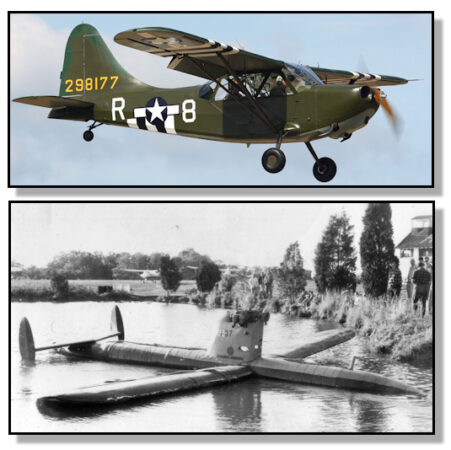This is a story about small airfields of Monmouth County that are now long gone.
During World War II, residents of Monmouth County became accustomed to seeing a number of small aircraft, midget planes known affectionately as “Flying Jeeps” passing overhead going hither and thither. Naturally, what they were up to was not to be discussed, loose lips and all that in a time of war.
These were a special lightweight military aircraft called the Stinson L-5 Sentinel. It was designed specifically for military use, and thus to be reliable, easy to fly, and capable of operating from short, unpaved airstrips, hence the comparison with the fabled Jeep.

We now know that these planes were being used for all manner of activity, at all hours of the day and night, in support of the U.S. Army Signal Corps at Fort Monmouth. Missions included pilot training, courier duty, and experimental research on behalf of the Army. Among the most noteworthy achievements in our area, these Flying Jeeps were instrumental in the Signal Corps development of a method of laying cable wire from an airplane, allowing communications wire to be laid in minutes in jungles or other inhospitable terrain, where previous methods required days of backbreaking labor. The Stinsons were also used as practice targets for developing radar-based searchlight tracking of enemy aircraft.
The Flying Jeeps were based out of Red Bank Airport, which is now a mixed-use development area in Tinton Falls. At the time, this area was a part of Shrewsbury Township. It broke away and became New Shrewsbury in 1950, and then adopted the new name of Tinton Falls in 1975.
Red Bank Airport was built in 1926 by Air View, Inc., on part of the George Hance Patterson farm. Air View services included aerial photography, taxi service, flight training, ground school instruction, sight-seeing trips and plane and engine repair. After a series of accidents caused a public outcry, Red Bank Airport closed in 1970.
Today, if you are driving along Shrewsbury Avenue, just north of Sycamore Avenue in Tinton Falls, and you look to the east, you will see the high-power electric lines that run along the nearby railroad tracks are lowered for about a quarter of a mile. This was to allow for longer and safer takeoffs and landings from the field, and is perhaps the last visual vestige of the former airport.
Not far away, another now-gone local airfield was host to a very different type of experimental military vehicle.
The Reid Flying Submarine

On June 4, 1963, Donald V. Reid of Asbury Park was granted his third U.S. Patent on the Reid Flying Submarine, Patent Number 3,092,060, the world’s first operational submersible aircraft. Developed during the Cold War era, the military potential of such a craft was seen by many as compelling, and the inventor worked tirelessly to get his flying submarine off the drawing board and into the water. Reid, an inventor, was a high-energy person of many interests and talents, as well as a technical genius. Bruce Reid, his son, helped his father assemble the craft in their Asbury Park back yard, and became the test pilot of the “RFS-1.”The flying sub was berthed in a freshwater pond on the site of Schlossbach Field, a 125-acre parcel of farm land in Neptune Township, off Route 66, where today you can find a Walmart and a Home Depot. Naval aviator Issac Schlossbach purchased the land in 1935 and opened an airport in 1938 under the name Ike’s Jersey Aero Club, one of the first airports in central New Jersey. It was dedicated on July 31, 1941, featuring two unpaved runways. It later became known as the Asbury Air Terminal.
Bruce Reid recalled, “My dad was manufacturing patented radio-controlled model submarines as a business when a set of model airplane wings accidentally fell from a shelf across the hull of one of them in his basement workshop. Dad looked at it for a moment and asked ‘Why not, why not a flying submarine?’ That was the birth of an idea that ‘consumed’ the rest of his life.”
The prototype was completed in 1961 using parts from other aircraft. In the air it was powered by a 65-horsepower four-cylinder Lycoming engine mounted in a pylon atop the hull (or fuselage, depending upon your point of view). While underwater, a 1-horsepower electric motor provided propulsion.
The vessel (or aircraft) had to be converted for use either as an airplane, or a submarine, but conversion from air to underwater duty was a clumsy affair. The pilot first had to remove and stow the propeller from the pylon, and then cover the engine housing with a rubber diving bell to keep the engine dry. The pilot used scuba gear to breathe underwater. Maximum depth was roughly 10 to 12 feet.
On June 9, 1964, following lengthy testing, the aircraft successfully went through a full cycle for the first time when a dive to a depth of 6.5 feet was followed by a short flight at an altitude of 33 feet.
This may not sound too impressive. But when you consider this was built by one man, from spare parts, on a limited budget and over 50 years ago, it’s simply astonishing. With more time and money surely its performance could have been radically improved; the RFS-1 should really be thought of as a proof-of-concept vehicle more than a production-ready design. Sadly, however, Reid was unable to find any backers for the project and it never went any further.
Reid wasn’t the first person to come up with the idea of a flying sub – although he was the first to build one. In 1934, Boris Petrovich Ushakov, a student engineer at a Soviet military academy, drew up plans for a flying submarine capable called the LPL. In the air, the craft was powered by three gas engine propellers, with two electrically powered engines for underwater operation. Design plans called for a three-man crew, a range of about 500 miles and the ability to fly low at night to infiltrate behind mine traps in enemy military harbors, dive underwater, and then deliver two 18-inch torpedoes while eluding capture. The viability of the concept was found by military authorities as compelling, as was the case with Reid’s idea, enough for a full review of the proposal in 1936, but the design was deemed too heavy to be viable.

In 1977, the Asbury Park Neptune Airport fell victim to economic and demographic forces that were changing the landscape of Monmouth County and all of New Jersey. Just as with Red Bank Airport (in Tinton Falls), and Marlboro Airport, the explosive growth of suburban residential developments built adjacent to airfields inevitably led to complaints about noise, concerns about accidents, and significantly higher real estate taxes for airfield owners.
In 1996, the New Jersey General Aviation Study Commission’s Subcommittee on Airport Closings looked at reasons behind the closing of 13 New Jersey general aviation airports. According to their report, taxes at Asbury Park’s airport had risen more than 600 percent from 1966-1972, from less than $6,000 to $36,000 per year. These same pressures led to the closing of the Marlboro Airport in Matawan in 2002.
Sources:
‘Flying Jeep’ Played Part In Developing War Aids. (1946). The Asbury Park Press, February 3, 1946, P. 15.
Freeman, Paul. (2021). Abandoned & Little-Known Airfields: Eastern New Jersey. Available: http://www.airfields-freeman.com/NJ/Airfields_NJ_E.htm
Reid, Bruce D. (2012). The Flying Submarine: The story of the Invention of the Reid Flying Submarine. Heritage Books, Inc., Westminster, Md., 2012.
Catfish. (2011). The LPL, The Russian Flying Submarine Concept. September 22, 2011. Available: https://civilianmilitaryintelligencegroup.com/8788/the-lpl-the-russian-flying-submarine-concept
1961 photo of Bruce Reid entering the Reid RFS-1 Flying Submarine in the Asbury Park Air Terminal pond (courtesy of Bruce Reid).


Leave a Reply